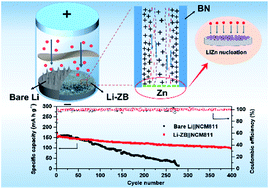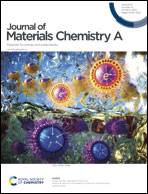Regulating lithium deposition behavior by electrokinetic effects in a high-zeta-potential h-BN/zinc-lithium alloy for high-performance lithium metal anodes†
Abstract
The commercial application of lithium metal anodes is impeded by the uncontrollable growth of lithium dendrites and the serious volume change during the cycling process. Here we develop a high-zeta-potential h-BN-doped zinc-lithium alloy (Li-ZB) as an anode to self-drive electrokinetic effects and regulate the lithium deposition behavior to achieve high-performance lithium metal batteries. The high-zeta-potential h-BN in Li-ZB promotes electrokinetic surface conduction and electroosmosis within the porous Zn-BN framework formed after lithium stripping, which in turn greatly enhances lithium-ion transport kinetics. Uniform Zn distribution in Li-ZB enables homogenous lithium nucleation and a reduced nucleation barrier. The synergistic effect of electrokinetic effect enhanced lithium-ion transport and regulated lithium nucleation behavior effectively suppresses lithium dendrite growth and mitigates the volume change issue at high deposition capacities (8 mA h cm−2), high current densities (10 mA cm−2), and a high rate (5C). The Li-ZB‖LiNi0.8Co0.1Mn0.1O2 full cells exhibit excellent cycling stability and capacity retention, as well as significantly enhanced CE, even under lean-electrolyte conditions (e.g., 3 μL mA h−1). The designed Li-ZB anodes show great potential application for next-generation lithium metal batteries with high energy density.



 Please wait while we load your content...
Please wait while we load your content...